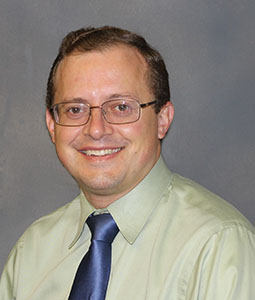Department of Chemistry and Biochemistry
Faculty and Staff Directory
Andrew B. Greytak
| Title: | Professor / Physical and Theoretical Inorganic / Materials / Nano / Solid State / Spectroscopy / Supramolecular |
| Department: | Chemistry and Biochemistry McCausland College of Arts and Sciences |
| Email: | greytak@mailbox.sc.edu |
| Phone: | 803-777-0672 |
| Fax: | 803-777-9521 |
| Office: | GSRC 409 |
| Resources: | CV[pdf] All Publications Andrew Greytak Group Website |

Education
B.S., 2000, Massachusetts Institute of Technology
Ph.D., 2006, Harvard University
Honors and Awards
Distinguished Research Service Award, USC, 2022
Mungo Undergraduate Teaching Award, USC, 2020
Breakthrough Rising Star Award, USC 2019
USC Two Thumbs Up Award, 2018
ACS-CEI Award for Incorporating Sustainability into Chemistry Education, Committee
on Environmental Improvement, American Chemical Society, 2014
Sustainable Carolina Curriculum Award, USC, 2013 and 2015
Research Interests
Crystalline materials with nanometer-scale physical dimensions often display different properties than bulk crystals of the same compounds, because they are smaller than characteristic length scales for light absorption and scattering, excited electronic states, and charge transport (conductivity). This is most readily seen in the size-dependent absorption and emission spectra of fluorescent semiconductor nanocrystal “quantum dots.”
Quantum dots are now ubiquitous in fluorescent backlights for flat panel TVs, computer monitors, and mobile devices because their narrow emission spectra allow the rendering of highly saturated colors. However, only a limited understanding exists of many details of the chemical and physical properties of colloidal quantum dots.
Our group develops surface-sensitive metrics, purification strategies, and synthetic steps for QDs and other colloidal nanocrystals that permit increasingly precise and sophisticated control of the resulting physical and chemical properties. Such control is necessary for improving the performance of QD solar cells and other nanocrystal-based devices, and for advancing the biomedical applications of nanocrystal-based imaging and therapeutic agents. We are also interested in the transport of matter, charge, and energy within nanoscale systems and across interfaces. We use microfabrication, optoelectronic measurements, and functional imaging techniques to characterize these transport processes.
Graduate and undergraduate students with a variety of academic interests including physical, inorganic, and organic chemistry; physics; biological sciences; and electrical engineering will be able to make strong contributions to the group’s research. Group members employ techniques including air-free synthetic chemistry, NMR spectroscopy, calorimetry, chemical vapor deposition, scanning and transmission electron microscopy, microfabrication, and photoluminescence imaging and spectroscopy. Instrument control, data analysis, and technical image analysis is done with computational tools such as Matlab and Labview. Please consult our group’s research website for information on current projects and opportunities to get involved.
Selected Publications
Andrew B. Greytak,* S. L. Abiodun, J. M. Burrell, E. N. Cook, N. P. Jayaweera, M. M. Islam and A. E. Shaker. Thermodynamics of Nanocrystal–Ligand Binding through Isothermal Titration Calorimetry. Chem. Commun. 2022, 58, 13037–13058. https://doi.org/10.1039/D2CC05012A.
Sakiru L. Abiodun, Megan Y. Gee, and Andrew B. Greytak.* Combined NMR and Isothermal Titration Calorimetry Investigation Resolves Conditions for Ligand Exchange and Phase Transformation in CsPbBr3 Nanocrystals. J. Phys. Chem. C 2021, 125, 17897–17905.
Fiaz Ahmed, John H. Dunlap, Perry J. Pellechia, and Andrew B. Greytak.* A p-type PbS quantum dot ink with improved stability for solution processable optoelectronics. Chem. Commun., 2021, 57, 8091-8094.
Mathew L. Kelley, Fiaz Ahmed, Grigory Simin, Kamal Hussain, Asif Khan, Andrew B. Greytak,* and M. V. S. Chandrashekhar.* Spatially Resolved Fourier Transform Impedance Spectroscopy: A Technique to Rapidly Characterize Interfaces, Applied to a QD/SiC Heterojunction. Applied Physics Letters, 2021, 118, 223102.
Yi Shen, Adam Roberge, Rui Tan, Megan Y. Gee, Dylan C. Gary, Yucheng Huang, Douglas A. Blom, Brian C. Benicewicz, Brandi M. Cossairt and Andrew B. Greytak.* Gel permeation chromatography as a multifunctional processor for nanocrystal purification and on-column ligand exchange chemistry. Chemical Science 2016, 7, 5671.